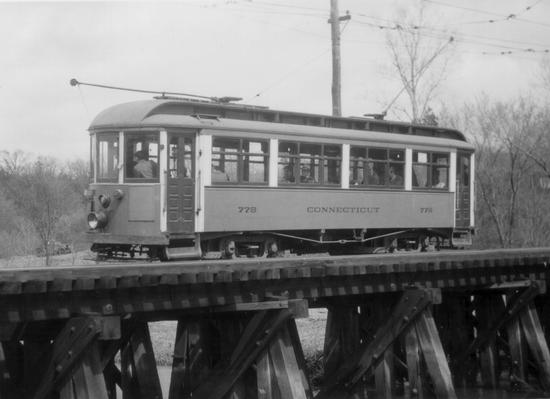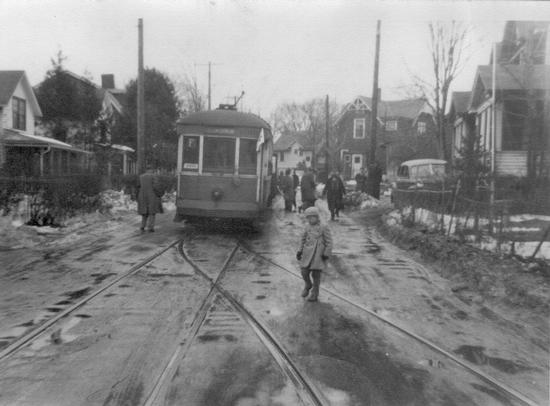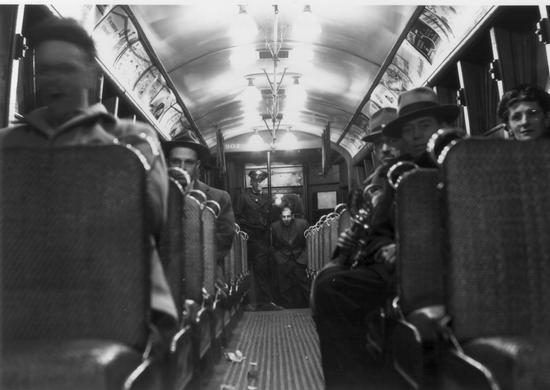
|
|
|
The End of the First Age of the Branford Elec. Ry.
That the Shore Line Trolley museum is the oldest operating railway
museum in the United States, and that its historic Branford Electric
Railway is the oldest continuously operating suburban trolley line, is
more a matter of luck than design.
As early as 1931, the Connecticut Company had announced its intentions to
abandon the Branford line. In 1937, the Stony Creek portion of the line
was abandoned and replaced with motor bus service. The remainder of the
line would have fallen at that time too, except for a small snag.
Ironically, it was the private right-of-way section that is now the museum
railway which stood in the way.
In converting to buses, the company was required to duplicate, as closely as
possible, the existing trolley route. In 1937, as in 1900, there were
two possible road routes between East Haven and Branford: the so-called
``high route'' via what is now U.S. 1, and the shore route. The former
was too far removed from the trolley right of way to be an equivalent
replacement -- it would have left Short Beach isolated. Therefore, the
buses would have to run south down Hemingway Avenue, then east along
Short Beach Road (State Route 142), crossing the Farm River (a.k.a. the
East Haven River) into Short Beach and then resuming along the original
trolley route beyond the intersection at Bradley Avenue (now Court Street).
The bridge over the Farm River has a long and rich history, which will be
the subject of an upcoming article on Johnson's Quarry. In 1937,
this structure was an iron
drawbridge about 30 years old. It was no longer being used as an active
drawbridge, that role having dried up years earlier when the quarry
quit. The bridge was not large enough or strong enough to allow motor bus
traffic, and therefore bus conversion would have to wait until a new
bridge could be constructed.
|
It was several years before these plans materialized. On July 17th
1941, H.S. Palmer, who had taken over the presidency of ConnCo from
J.K. Punderford during the bankruptcy proceedings of 1936, announced that
buses would be substituted shortly, as the State Highway Department was
ready to build a new bridge. This bridge, it was announced, would be
of modern structural steel, concrete-encased construction, 35 feet wide
with a 750 foot span, and would be built by Mariani Construction.
Buses Invade Branford
The New Haven Register on July 26th 1941 lamented:
New Haven-Branford trolleys will quit when Short Beach bridge
is done. But do New Haveners have to wait that long?
* * *
The Connecticut Co. is making money and can afford to
buy buses. Let's have an end to dawdling motormen!
and on August 19th 1941:
Trolley cars roll on their last wheels in New Haven, only city
in Connecticut still using the veteran vehicles...
Like the buffalo, lumbering yellow electric cars are fast becoming
extinct, vanishing from city streets to re-appear strangely
as summer cottages, restaurants, chicken coops or sundry other shelters.
These editorials require little elaboration. Throughout the country, the
internal combustion engine was seen as the enabler of the American
dream. Trolleys were viewed as antiquated, and buses sleek and modern.
Ironically, many decades later, the ``light rail'' renaissance would reverse
that view.
In August of 1941, the Kirkham St. bridge over the New Haven R.R.
tracks required rebuilding, severing the trolley line there.
Therefore on August 4th, ConnCo cut back service to the
nearest cross-over, at the ``Red Barn'' location at Stannard
Ave. Passengers for Branford Center had to continue their
journey via bus.
Meanwhile, a shortage of structural steel meant
that the new Farm River bridge would be delayed. The Branford
line had received another stay of execution. The bridge would eventually
be completed late in the fall of 1942. However, events a half a world
away would intervene and keep the trolleys running for several more years.
The War Years
On December 7th 1941, the United States was drawn into World
War II by the bombing of its naval base at Pearl Harbor. Rations were
imposed on gasoline, oil, rubber, aluminum, steel and other materials
that were needed to wage war. In April of 1942, Washington D.C.
sent down the order that all street railway companies must continue to
use their existing infrastructure, and forbid the consumption of resources
on bus conversion.
The vigorous industrial production and low unemployment necessitated by
the war drew the country out of its decade-long economic downturn.
New Haven's trolley system was busier than it had been in over a score.
Many of the older cars, sidelined for years, were pressed into service, and
several abandoned routes were resurrected.
Throughout the war years, the 1900 series cars remained assigned to the
Branford line, however, the older cars were known to pop up then and again
as ``trippers.''
Although revenue was up, the Connecticut Company was surely not re-investing
it in trolley infrastructure. The entire system was in a holding pattern
pending bus substitution. Spot repairs were made as needed to keep the
cars running at minimal expense. Unfortunately, this would mean that those
cars that did get preserved were well-worn, as was the trolley line that
the museum inherited in 1947.
Being the last city in Connecticut to run trolleys, New Haven became
a Mecca for trolley fans. Many photographs of this time period survive.
In addition, several preservation groups began to emerge, a topic which will
be covered further in the next installment of this series.
On September 29th 1941, the New Haven Register ran this
amusing story concerning motorman Tom King, at this time the senior man
on the Branford line, and presumably the same Tom King who was involved,
as a conductor, in the 1910 fatal collision at Pine Orchard:
One day last week Tom King,
veteran trolley operator on the Branford division was running
his car through private way over East Haven meadows and approaching
trestle at Johnson's quarry noticed police dog running toward car,
barking and leaping up and which would not get off track.
* * *
Tom slowed down and stopped on trestle, between the ties another
police dog had gotten caught and was hanging by his paws.
* * *
Tom pulled him out, uninjured, and in his apparent joy at being
released began to lick the other dog all over.
A storm on November 10th 1942 washed out the tracks near Granite
Bay, yet again. Another round of temporary repairs was made to keep the
line going.
 |
| Car 775 is inbound on the East Haven trestle. The year is 1942 Scholes Photos |
One of the rituals of the war years was the scrap drive. Any unused metal
was a candidate for recycling into the instruments of battle. In 1942,
the War Department set its sights on 188 tons of scrap steel -- the
rails in the streets of Branford beyond Red Barn which were now idle.
It is likely that they were scrapped sometime in 1942.
The Final Year
Japan's surrender was announced on August 14th 1945,
ending World War II. The slow process of
rebuilding the world would now begin. The wartime ban on bus substitution
was lifted, but the New Haven trolleys would receive yet another
extension. There was a severe backlog of new bus orders, and it would
take several years for bus manufacturers to catch up.
Starting April 22nd 1946, trolley service on the Branford line was
cut back again by nearly 2 miles. The State Highway
Department began the reconstruction of Main Street (Route 142) in Short Beach,
which required the removal of the trolley
tracks from the street. The bus/trolley transfer point was moved to
Bradley Avenue (now Court Street),
at the ``Post Office corner'', a block beyond the current end
of the museum's line.
 |
| During the final year, this was the turn-back point, a few hundred feet from the present-day end of the museum line. Car 1920 is changing ends on the stub track at Court street (at the time called Bradley Avenue) and will soon return to New Haven. coll. J. West |
New buses were now arriving.
The end for the Branford line would come within a year.
In the early hours of March 8th 1947, car 1902 made the
last run from Short Beach. Alas, while this was the end of passenger
service, the line would be reborn!
Bus service for passengers has replaced the present rail or trolley
cars on the New Haven-Branford route and also on the New Haven-
Momauguin line, the change-over made possible by the arrival of
a fleet of new 40-passenger gas-hydraulic Mack buses.
The Connecticut Co. will take up rails from East Haven Green
over the meadows excepting about 7000 feet which is to be used
under an arrangement with the Connecticut Co. by the Branford
Electric Railway Association, which plans to make use of the trackage
in connection with a projected museum for ancient cars used for
street passenger transportation. Tracks will remain intact
until the BERA can provide housing on the meadow to house their
cars. The tracks on Bradley Avenue, Short Beach will be removed
at an early date.
The veteran car operator on the Branford line is Thomas King
of 35 Rowe Street, New Haven, with a record of 45 years as
car operator on that route. King will transfer to the Lighthouse
line. He declined an invitation to operate the last car over the
line as he is reluctant to operate at night.
The last car left Short Beach at 12:45 where flood lights for
photographers were supplied from the home of Mr. and Mrs.
Walter J. McCarthy.
By the time the trolley reached the car barn it was devoid
of identification and removable accessories.
[ Branford Review, March 13th 1947]
 |
| It's 12:15 A.M. on March 8th 1947, aboard the last regular service car from Short Beach to New Haven. J.H. Koella |
The Shore Line Trolley Museum
17 River Street
East Haven, CT 06512
(203) 467-6927
[ Home ]
[ About The Museum ]
[ Donate! ]
[ The Collection ]
[ Membership ]
[ Guest Operators ]
[ Volunteer ]
[ Site Map ]
[ Members Only ]
This material is copyright © 1997-2020 Branford Electric Railway Assoc. All rights reserved.
Last Updated: /articles/bery100p4.in modified at Thu Mar 10 23:27:50 2005
Comments-To:
webmaster@bera.org



